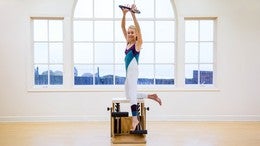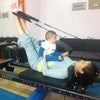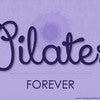Description
About This Video
Transcript
Read Full Transcript
Welcome to Pilates Anytime. I'm Elizabeth Larkam, really delighted to be back with you. This is my seventh year with Pilates Anytime, a clear indication that the practice of pilates just makes you younger. We're filming in early January of 2018 and we'd like to send heartfelt wishes to everyone who was affected by the southern California fires. In this program, in this class on the reformer, we'll work with the principles of biotensegrity meaning the interplay of tension and compression in the body.
So we'll have some moves that work on compression, forces pressing inward and some moves forces pushing outward and in all cases we're interested in the interplay of those two forces because that's necessary to get around well in gravity. When you start, I suggest a blue spring attaching the carriage to the frame and the foot bar can be on the low level or the medium level and you'll have a short box in place. Now, this is just to establish the feeling of what's involved in keeping your torso fairly steady while you're involved in hip extension. Initially, you have the front of your heel in contact with the bar. Pressing your elbows, your forearms into the box, either palms towards you or palms upwards towards the ceiling.
Pressing your forearms, your elbows into the box. So you bring your chest bone, your thoracic area up to the spine between the shoulder blades. Now, give each side a turn to work on the front of your heel aiming the ASIS of the lifted leg towards the knee of the supporting leg. Tucking your chin inward just a little bit opening the space the base of the occiput so that the back of your neck is long, your gaze will be between the shoulder rests onto the headrest. You'll progress from there to have the sole of your toes and the ball of your foot on the foot bar articulating through your ankle in plantar and dorsi flexion.
Continue to aim the ASIS of the lifted leg towards the inner knee and give this a turn to each side steering your knee over your second or your third toes. Now, if all's going reasonably well, you could keep your torso level and steady in the center and lift up the same side arm as the knee ... (bumping) Sorry for that bump, as the knee that is on the carriage giving you a diagonal support from the knee on the carriage to the forearm on the box. Put this arm down, the arm that has been lifted, and now you'll shift your entire central axis so the light from your chest bone is above the forearm that's on the box and you aim the ASIS of the lifted leg towards the knee of the supporting leg. Now, bring both forearms over to the side opposite your supporting knee and change both forearms over to the side of the same side knee.
These are five different arm variations just getting you accustomed to what will be required shortly in the more demanding balance without the box. Take those same five arm variations on the new side, the sole of your toes, the ball of your foot in contact with the foot bar. Drive into dorsi flexion and plantar flexion. Whichever arm corresponds to the knee on the carriage, lift that arm up, shift your whole central axis so the light from your pubic bone, the middle of your pubic bone shines over the knee on the carriage and the light from your chest bone over your forearm on the carriage. Level your pelvis.
Bring both forearms over to be even with the foot that's on the foot bar. Pressing your forearms into the box so that you sustain your thoracic kyphosis. Sure, I'll get right on it. And then over to the other side. Two end, three end, four end.
We finish this preparation for the hip extension this time with five different arm variations. Now, we'll get rid of the box for just a moment in order to take an intermission from kneeling that involves more focus on decompression. We'll put the box behind the carriage. Is that alright? Behind the frame.
Now we have no springs at all. And you stand with your feet straddling the axis of the shoulder rests. Bend both knees, the hand closest to the foot bar points to the risers and the hand closest to the risers aims straight ahead. As the carriage turns, pull with your right hand, push with your left, aim your sitting bones up and back behind you so that your right lung is turning in front of you to the left, your left lung is turning behind you to the right. And do that again this time turning your head, neck and eyes to see the frame between the shoulder rests.
Now, swivel your feet so that you face the diagonal of the carriage, this corner of the carriage and as the carriage slides, pull with your right hand, push with your left taking a nosedive to the carriage, both elbows are straight and both knees are bent. Turning, rotating your thoracic spine and your head, neck and eyes. Swivel your feet, your legs so that you stand on the complementary diagonal. As the carriage slides, pull with your close hand. That's the right hand.
Push with your far hand. That's the left hand. Aiming your sitting bones up and back behind you, encouraging thoracic rotation in the new direction and I did that badly. I was turning the head. In this case, aim the nose towards the carriage.
Normally, I was aiming the nose towards the carriage first and then turning the head second. Now, these same three thoracic rotations you practice on the other side. Making sure that the carriage is all the way home, the foot bar hand is on the close shoulder rest and the riser hand is on the far shoulder rest. Your feet are straddling the axis of the shoulder rests, both knees are bent, both elbows are straight. As you inhale, pull with your close hand, that's the left hand, push with your far hand, that's the right hand aiming your sitting bones up and back behind you as you take a nosedive towards the carriage.
And you do something similar as your ear listens to the carriage and you look through the shoulder rests to see the frame. Now, swivel your feet in the direction of the foot bar first. Inhale to rotate, exhale to come up. Inhale to rotate, pulling, pushing, balancing the forces of tension pressing outward and compression pressing inwards, pulling towards you with your left hand, pushing away with your right aiming your left sitting bone a long way from your right arm. Having finished this intermission, we'll bring the short box back on in order to do the kneeling side leg kicks.
With the short box in place and the blue spring at the top button on the carriage, you'll have your thigh up against the box and your foot bar foot all the way forward on the foot bar. Now, you have options. You always have options. You can have your hand over the side of the carriage. You can also bend your elbow and place your forearm, your elbow on the carriage.
You choose the one that makes you feel the most comfortable, the one that makes you feel the most stable. As you inhale, you push out, exhale to come in pushing your elbow, your forearm down into the box and steering your knee forward over your toes. Now, rotate your thoracic spine so that your chest bone faces the box and you have both forearms on the box steering your hips back behind you. Whichever is the back arm, take it off the box and then change to the back arm and take the front arm off the box. Staying on this same side, change your foot from forward on the foot bar to all the way back on the foot bar.
So you can either return to your forearms on the box or keep your hands on the box and we'll do this version now. With your hand on the box pressing your shoulder blade down into the heel of your hand. Here you'll be able to articulate your ankle because your foot's behind you in hip extension. Turn so that both hands are on the box, the light from your chest bone shining on the box between your hands. A reminder, she said to herself and to you, to steer your knee forward over your third toe in knee flexion rather than inward.
Whichever is the back arm, lift it off. And whichever is the front arm, lift it off, too. Change now to the new side. Here you are with your thigh up against the side of the box, your foot forward on the foot bar, the first and second toes on the foot bar, the heel as well. Place your forearm down on the box and drive out through knee extension and hip extension lifting up your ribs high above the box.
Ribs and waist lifted. Turn to face the box so that your forearms are on the box, both of them. Keep your knee aiming forward over your third toe and your pelvis has turned slightly on your femur head towards the box. Whichever is the back arm, lift it off. Return the back arm and shift your weight as necessary as little as possible in order to lift your front arm.
Continue steering your knee forward over your toes. Change now so that the foot at the front of the bar is now the foot at the back of the bar in hip extension and you can have one hand on the box pressing your hand into the box so that your shoulder comes down, your ribs and waist lift up and articulating your ankle in plantar and dorsi flexion. Turn to face the box, hands wide. When you have your hands on the box as opposed to your elbows, it'll be a little bit easier to differentiate thoracic rotation so your pelvis doesn't have to turn as much towards the box. Whichever is the back arm, lift it off.
Exhale to slide out, inhale to lift. And now change arms so the back hand is on the box and your front hand is off, steering your knee forward over your third toe. You won't be using the box now, so we can get rid of the box. And you won't need any springs either because it's time for the next iteration of the decompression spirals. Standing now with your feet in line with the shoulder rests, ankles close together, big toe joints touching, you'll have the hand that's closest to the foot bar on the shoulder rest and the other hand forward.
This time, both knees are extended. As you inhale, you take a nosedive in the direction of the carriage. Sitting bones lead up and back behind you. Pulling with your right hand, that's the hand closest to you and pushing away with your left hand. De-rotate bringing the carriage in and do something similar aiming your head, neck and eyes so that you can look through the shoulder rest towards the frame and your ear listens to the carriage.
Now swivel so that your toes are aiming towards the carriage, towards the foot bar diagonal. Inhale to rotate, exhale to come up. Inhale to rotate, keeping your weight firmly on the big toe that's closest to the foot bar. Now swivel on your feet so you face the new diagonal, pulling with the close hand, that's the right hand, pushing with the far hand, that's the left hand. Sitting bones lead up and back behind you as you take a nosedive.
And then as you take an eardive, keep your weight firmly on the foot that's closest to the foot bar so that you are indeed rotating around your central axis rather than side bending first and rotating sometime later. Change now to the new side. Make sure the carriage is all the way home. Your big toes and ankles, close by each other, the foot bar hand on the shoulder rest closest to you and the other hand on the far shoulder rest. As you inhale, move your pelvis over the head of your femurs aiming your sitting bones up and back behind you.
Pull with the close hand, push with the far hand and avoid the tendency to shift your weight towards the risers. Stay on the foot that's towards the foot bar. Coming up. As you inhale, turn to see the frame between the shoulder rests. Swivel your axis now so that you face the diagonal of the carriage, the corner of the carriage.
Inhale to rotate, pull, push, go and nosedive. Exhale to come in and now your head, neck and eyes turn to see the frame. Swivel, staying in this same position with respect to the shoulder rests but a different orientation. Pull, push, go. And come back up.
Pull, push and turn. This particular decompression intermission is over. Now, place a blue spring back on the frame on the spring bar and when I use a spring, I always use it on the top deck, the upper deck there to make it a little bit stronger and bring the foot bar to its high position. Now, come onto your knees with your hands at the shoulder rests. One knee is in the center of the carriage from the front to the back, but this knee is in line with its own hip joint and put the sole of your toes, the ball of your foot on the foot bar.
And now, we'll take this all-purpose, myofascial continuity exercise ... (laughs) sure, we will, with seven different arm variations. Here we go. Exhale to push out, inhale to rise. We'll take two of each of these variations bringing your chest bone up to the spine between your shoulder blades.
Without a lateral shift, you lift the arm that corresponds to the knee on the carriage. Now, shift your weight so that your chest bone aligns over your thumb on the shoulder rest and a reminder that this ASIS aims towards that inner knee. Both hands on the same side shoulder rest, make sure both hands are contacting the shoulder rest. Whichever is the outside hand, that arm lifts. And now you change both hands to the new shoulder rest, aligning your chest bone there over both hands.
Continue your rhythm and bring whichever is the back hand, the outside hand, that's the hand that lifts. Now, that was seven different arm variations. Each one different than the other. Let's take the new side now. Here you are standing on your right knee.
You can have your hands on the shoulder rest. You can if you prefer have your hands on the carriage, if that feels more secure to you and better for your wrists and of course, if the shoulder rests come off, then you can build up some cush and some pad in order to decrease your restrain. So you always have options, the box, the shoulder rests, the carriage or some pads. Having your heel in line with your sitting bone, as you exhale, push out. Rise to your toes and lower, drawing your lowest front ribs in and up and lengthening the back of your neck.
Take one arm off, so you have a secure diagonal support of one hand and the opposite knee. Shift laterally, leveling your pelvis by aiming the lifted ASIS towards the supporting knee. Bring both hands towards the open shoulder rest, the one that was previously free. Continue your rhythm as you take the outside arm off. And transition to both hands on the new shoulder rest.
It's always the new, you know, it's never the other. Whichever is the outside arm, lift it up. Now, we'll take an intermission from kneeling and for that you could bring the foot bar down and add a red spring. Climb aboard the carriage with your hands wide on the foot bar, anchor your heels into the carriage against the shoulder rests. Exhale to slide back.
As the carriage comes forward, aim your sitting bones up and back behind you and bring your whole spine closer to your thighs. Cross one foot in front of the other and continue this motion leading up and back with both sitting bones especially the one that belongs to the back leg. Change to the new side. Crossing over, leading up and back with both sitting bones especially the one that belongs to the back leg. Change to the first side again and this time both hands will be opposite the feet on the carriage.
Change sides. Crossing over, both hands opposite the feet on the carriage. Now, in order to work with the kneeling side leg kick or side leg press, take the red spring off and bring your supporting knee in the center of the carriage front to back, side to side. You'll have your supporting hand on the back shoulder rest and you will have your foot on the foot bar. Let's bring the foot bar all the way up.
The higher the foot bar, the more challenging the exercise will be because you'll have more range of motion in hip flexion and knee flexion. Exhale to slide out, inhale to come in. Lift up your ribs and lift up your waist, broaden across your chest bone. Both hands on the shoulder rests aiming your chest bone between your thumbs. Whichever is the back arm, that arm hovers off as your front knee aims over your toes.
Both hands go on the back shoulder rest, thoracic side bending and rotation and whichever is the back hand, that arm comes off. Take this much on the second side. Aim your knee in the center of the carriage. One leg is in hip flexion. Exhale to slide out lifting up your ribs and lifting up your waist.
Steering your knee forward over your toes, thoracic rotation to steer between your thumbs. Whichever is the back arm, that arm lifts off. Both hands come together on the back shoulder rest. And whichever is the back hand, that arm lifts. Now, we'll take the hip extension version of the side leg kick.
Sure, we will. Bring your hand forward onto the shoulder rest and your foot back on the bar and hip extension. Exhale to slide out, inhale to rise. Change hands now. One hand to the back, one hand to the front.
Whichever is the back hand, lift that off. Stay high as you can on your supporting hip joint. Both hands to the back shoulder rest. You are winding up around your supporting hip and take the back hand off. I could put my tongue in my mouth, but I was thinking if I stuck it out, it might help me do that better.
Other side. Your knee in the center of the carriage, one foot at the back, one hand forward, exhale to slide out, inhale to rise. Change, aiming between your thumbs. Lift up your back arm. Both hands on the back shoulder rest.
And lift up the back arm. For an intermission from kneeling, we'll bring the foot bar down and we'll add a red spring as before. Climb onto the carriage, anchor your heels, both arms wide aiming your sitting bones up and back, pressing away from the little finger side of the heels of your hands. One hand reaches towards the opposite ankle and you rotate. Pushing with the hand on the foot bar, pulling with the hand on your ankle, bringing your whole torso closer and closer to your thighs as you encourage rotation looking up in the direction of the ceiling.
Change now to the new side. Without a weight shift, reach underneath to take a hold meaning without a lateral translation of your weight shift. Push with the hand on the foot bar. Aim the opposite sitting bone up and back behind you to create a diagonal force. Reach across to your ankle and begin coaxing your torso closer and closer to your thighs.
Aim the sitting bones away from your hand increasing rotation by pushing with the hand on the foot bar and pulling with the hand on your ankle. Aiming your gaze upwards in the direction of the ceiling. Thank you so much for joining us for this movement exploration of biotensegrity, the interplay of tension and compression. I look forward to being with you again. Thank you so much, Pilates Anytime.
Bye.
Comments

You need to be a subscriber to post a comment.
Please Log In or Create an Account to start your free trial.



































